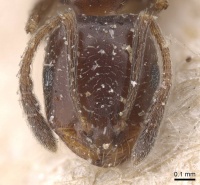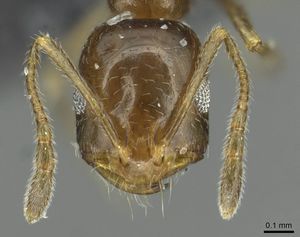Monomorium abeillei
| Monomorium abeillei | |
|---|---|

| |
| Scientific classification | |
| Kingdom: | Animalia |
| Phylum: | Arthropoda |
| Class: | Insecta |
| Order: | Hymenoptera |
| Family: | Formicidae |
| Subfamily: | Myrmicinae |
| Tribe: | Solenopsidini |
| Genus: | Monomorium |
| Species group: | salomonis |
| Species: | M. abeillei |
| Binomial name | |
| Monomorium abeillei André, 1881 | |
| Synonyms | |
| |
This is a wide-ranging Middle Eastern species found throughout Arabia from coastal lowlands to high mountains (Collingwood and Agosti 1996). Heatwole (1990) found Monomorium ants to be the commonest component of the desert ant fauna in the United Arab Emirates sand dunes. This species (under the name M. wahibiense) was the most numerous and is clearly a true desert-adapted species (Collingwood and Agosti 1996).
Identification
Distribution
Latitudinal Distribution Pattern
Latitudinal Range: 34.341944° to 13.083333°.
| North Temperate |
North Subtropical |
Tropical | South Subtropical |
South Temperate |
- Source: AntMaps
Distribution based on Regional Taxon Lists
Afrotropical Region: Saudi Arabia, United Arab Emirates.
Palaearctic Region: Afghanistan, Iran, Israel (type locality), Kuwait, Oman (type locality).
Distribution based on AntMaps
Distribution based on AntWeb specimens
Check data from AntWeb
Countries Occupied
| Number of countries occupied by this species based on AntWiki Regional Taxon Lists. In general, fewer countries occupied indicates a narrower range, while more countries indicates a more widespread species. |

|
Estimated Abundance
| Relative abundance based on number of AntMaps records per species (this species within the purple bar). Fewer records (to the left) indicates a less abundant/encountered species while more records (to the right) indicates more abundant/encountered species. |

|
Biology
Castes
Images from AntWeb
   
| |
| Paratype of Monomorium wahibiense. Worker. Specimen code casent0913864. Photographer Z. Lieberman, uploaded by California Academy of Sciences. | Owned by NHMB, Basel, Switzerland. |
Nomenclature
The following information is derived from Barry Bolton's Online Catalogue of the Ants of the World.
- abeillei. Monomorium abeillei André, in Emery, 1881b: 531 (footnote, and in key) (w.) ISRAEL (date of publication 9.iii.1881).
- Type-material: syntype workers (number not stated).
- Type-locality: Israel (“Palestine”): Jaffa (= Tel Aviv-Yafo) (Abeille de Perrin).
- Type-depository: MNHN.
- [Also described as new by André, 1881b: 67 (date of publication 22.vii.1881).]
- Combination in M. (Xeromyrmex): Emery, 1922e: 177.
- Subspecies of salomonis: Forel, 1910a: 23; Emery, 1922e: 177; Menozzi, 1933b: 66 (in key); Hamann & Klemm, 1967: 413.
- Status as species: André, 1883a: 335 (in key); Dalla Torre, 1893: 65; Emery, 1908h: 678; Wheeler, W.M. & Mann, 1916: 171; Collingwood, 1961a: 61; Ettershank, 1966: 87; Collingwood, 1985: 269; Kugler, J. 1988: 258; Bolton, 1995b: 258; Collingwood & Agosti, 1996: 340; Paknia, et al. 2008: 155; Vonshak, et al. 2009: 43; Legakis, 2011: 14; Collingwood, et al. 2011: 432; Borowiec, L. & Salata, 2012: 517; Borowiec, L. 2014: 114; Tohmé, G. & Tohmé, 2014: 135; Khalili-Moghadam, et al. 2019: 177; Borowiec, L. & Salata, 2020: 13; Sharaf, Abdel-Dayem, et al. 2020: 547.
- Distribution: Afghanistan, Egypt, Iran, Israel, Jordan, Kuwait, Lebanon, Oman, Qatar, Saudi Arabia, Sudan, Syria, United Arab Emirates, Yemen.
- wahibiense. Monomorium wahibiense Collingwood & Agosti, 1996: 357 (w.) OMAN, UNITED ARAB EMIRATES.
- Type-material: holotype worker, paratype workers (number not stated).
- Type-locality: holotype Oman: Wahibi Sands, 6.viii.1986 (M.D. Gallagher); paratypes: workers with same data, workers United Arab Emirates: Djebel Haffete, 3-4.x.1984 (H. Heatwole), workers United Arab Emirates: Ras Ghanada, ix.1992 (B. Tigar).
- Type-depository: WMLC.
- [Note: Sharaf, Mohamed, Boudinot, et al. 2021: 21, report 1 ‘syntype’ in WMLC; other type-material possibly in OMHN if Gallagher material has been retained there, possibly in NCSU if Heatwole material returned there.]
- Status as species: Collingwood, et al. 2011: 438; Borowiec, L. 2014: 127.
- Junior synonym of abeillei: Sharaf, Mohamed, Boudinot, et al. 2021: 12.
Type Material
Monomorium wahibiense: Holotype: worker, Oman, Wahiba Sands, 6.VIII.1986, M.D. Gallagher. - Paratypes: Oman: workers, same series as holotype. - United Arab Emirates: workers, Djebel Haffete, 3-4.X.1984, H. Heatwole; workers, Ras Ghanada, IX.1992, B. Tigar.
Unless otherwise noted the text for the remainder of this section is reported from the publication that includes the original description.
Description
Collingwood and Agosti (1996) - TL 2.40-2.75; CI 78-91; SI 90-104; EL/HW 0.24-0.29.
Anterior margin of clypeus slightly concave. Eyes moderately large, about one quarter HW with 9-10 ommatidia in the longest row. Head almost straight-sided, occiput weakly emarginate in dorsal view with rounded corners. In profile the alitrunk has the promesonotal dorsum meeting the flat propodeum at an oblique angle. The propodeum has a characteristic well-defined, longitudinal V-shaped furrow bordered by a distinct raised edge at each side. The petiole in profile is a high rounded triangle, in dorsal view mildly transverse but not wider than the postpetiole. The pronotum has one pair of hairs, the petiole one pair and the postpetiole two pairs. There are a few scattered hairs on the first gastral tergite. The head, pronotum and nodes have superficial reticulate sculpture; the mesopropodeum and the sides of the head are coarsely punctate. The gaster is brilliant with very superficial sculpture. The body colour is evenly brownish black to black with reddish articulations, pale funiculi, tarsi and mandibles.
References
- Al-Qurashi, A.S., Mashaly, A.M., Alajmi, R., Al-Khalifa, M.S., Mansour, L., Al-Omar, S.Y., Sharaf, M.R., Aldawood, A.S., Al-Dhafer, H.M., Hunter, T., Almutawa, M.Y., Ahmed, A.M. 2023. A preliminary investigation of rabbit carcass decomposition and attracted ants (Hymenoptera: Formicidae) on the seaward coastal beach of Al-Jubail City, Saudi Arabia. Journal of Medical Entomology (doi:10.1093/jme/tjad162).
- André, E. 1881a. [Untitled. Monomorium Abeillei, n. sp.]. P. 531 in: Emery, C. Viaggio ad Assab nei Mar Rosso dei Signori G. Doria ed O. Beccari con il R. Avviso "Esploratore" dal 16 Novembre 1879 al 26 Febbraio 1880. I. Formiche. Ann. Mus. Civ. Stor. Nat. 16:525-535. (page 531, (footnote) worker described)
- André, E. 1881c. Catalogue raisonné des Formicides provenant du voyage en Orient de M. Abeille de Perrin et description des espèces nouvelles. Ann. Soc. Entomol. Fr. (6)(1): 53-78 (page 67, also described as new)
- Borowiec, L. & Salata, S. 2013. Ants of Greece – additions and corrections (Hymenoptera Formicidae). Genus (Wroclaw) 24, 335-401.
- Borowiec, L. 2014. Catalogue of ants of Europe, the Mediterranean Basin and adjacent regions (Hymenoptera: Formicidae). Genus (Wroclaw) 25(1-2): 1-340.
- Borowiec, L., Salata, S. 2020. Review of ants (Hymenoptera: Formicidae) from Jordan. Annals of the Upper Silesian Museum in Bytom, Entomology 29 (online 2): 1-26 (doi:10.5281/zenodo.3733156).
- Collingwood, C. A. 1985. Hymenoptera: Fam. Formicidae of Saudi Arabia. Fauna Saudi Arab. 7: 230-302 (page 269, Revived status as species)
- Collingwood, C. A. and D. Agosti. 1996. Formicidae (Insecta: Hymenoptera) of Saudi Arabia (part 2). Fauna Saudi Arabia. 15:300-385. (page 340, Revived status as species)
- Collingwood, C.A., Agosti, D., Sharaf, M.R., van Harten, A. 2011. Order Hymenoptera, family Formicidae. Arthropod fauna of the UAE 4: 405-474.
- Emery, C. 1922c. Hymenoptera. Fam. Formicidae. Subfam. Myrmicinae. [part]. Genera Insectorum 174B: 95-206 (page 177, Combination in M. (Xeromyrmex))
- Forel, A. 1910a. Glanures myrmécologiques. Ann. Soc. Entomol. Belg. 54: 6-32 (page 23, Subspecies of salomonis)
- Hamann, H. H. F.; Klemm, W. 1967. Ergebnisse der zoologischen Nubien-Expedition 1962. Teil XXXIV. Hymenoptera - Formicidae. Ann. Naturhist. Mus. Wien 70: 411-421 (page 413, Subspecies of salomonis)
- Khalini-Moghadam, A., Borowiec, L., Nemati, A. 2019. New records of ants (Hymenoptera: Formicidae) from the Chaharmahal va Bakhtiari Province of Iran with taxonomic comments. Polish Journal of Entomology 88: 163–182 (DOI 10.2478/pjen-2019-0013).
- Salata, S., Borowiec, L., Trichas, A. 2020. Review of ants (Hymenoptera: Formicidae) of Crete, with keys to species determination and zoogeographical remarks. Monographs of the Upper Silesian Museum No 12: 5–296 (doi:10.5281/ZENODO.3738001).
- Sharaf, M.R., Abdel-Dayem, M.S., Mohamed, A.A., Fisher, B.L., Aldawood, A.S. 2020. A preliminary synopsis of the ant fauna (Hymenoptera: Formicidae) of Qatar with remarks on the zoogeography. Annales Zoologici 70: 533-560 (doi:10.3161/00034541anz2020.70.4.005).
- Sharaf, M.R., Mohamed, A.A., Boudinot, B.E., Wetterer, J.K., Hita Garcia, F., Al Dhafer, H.M., Aldawood, A.S. 2021. Monomorium (Hymenoptera: Formicidae) of the Arabian Peninsula with description of two new species, M. heggyi sp. n. and M. khalidi sp. n. PeerJ 9, e10726. (doi:10.7717/peerj.10726).
References based on Global Ant Biodiversity Informatics
- Borowiec L. 2014. Catalogue of ants of Europe, the Mediterranean Basin and adjacent regions (Hymenoptera: Formicidae). Genus (Wroclaw) 25(1-2): 1-340.
- Borowiec L., and S. Salata. 2012. Ants of Greece - Checklist, comments and new faunistic data (Hymenoptera: Formicidae). Genus 23(4): 461-563.
- Collingwood C. A. 1961. The third Danish Expedition to Central Asia. Zoological Results 27. Formicidae (Insecta) from Afghanistan. Videnskabelige Meddelelser fra Dansk Naturhistorisk Forening 123: 51-79.
- Collingwood C. A. 1985. Hymenoptera: Fam. Formicidae of Saudi Arabia. Fauna of Saudi Arabia 7: 230-302.
- Collingwood C. A., D. Agosti, M. R. Sharaf, A. Van Harten, 2011. Order Hymenoptera, family Formicidae. Arthropod Fauna of the UAE 4: 405-474
- Collingwood C.A., D.Agosti, M.R. Sharaf, and A. van Harten. 2011. Order Hymenoptera, family Formicidae. Arthropod fauna of the UAE, 4: 405474
- Collingwood, C. A., and Donat Agosti. "Formicidae (Insecta: Hymenoptera) of Saudi Arabia (Part 2)." Fauna of Saudi Arabia 15 (1996): 300-385.
- Collingwood, C. A.. "Hymenoptera: Fam. Formicidae of Saudi Arabia." Fauna of Saudi Arabia 7 (1985): 230-302.
- De Stefani T. 1889. Miscellanea imenotterologica sicula. Nat. Sicil. 8: 140-145.
- Emery, C.. "Beiträge zur Monographie der Formiciden des paläarktischen Faunengebietes. (Hym.) Teil V. Monomorium." Deutsche Entomologische Zeitschrift 1908 (1908): 663-686.
- Emery, C.. "Viaggio ad Assab nel Mar Rosso dei Signori G. Doria ed O. Beccari con il R. Avviso "Esploratore" dal 16 novembre 1879 al 26 febbraio 1880. I. Formiche." Annali del Museo Civico di Storia Naturale 16 (1881): 525-535.
- Ettershank G. 1966. A generic revision of the world Myrmicinae related to Solenopsis and Pheidologeton (Hymenoptera: Formicidae). Aust. J. Zool. 14: 73-171.
- Hamann H. H. F., and W. Klemm W. 1967. Ergebnisse der zoologischen Nubien-Expedition 1962. Teil XXXIV. Hymenoptera - Formicidae. Annalen des Naturhistorischen Museums in Wien 70: 411-421.
- Izhaki I., B. Idelovich, R. Laster, and Y. Ofer. 2009. The impact of macro- vs micro environmental factors on the structure of ant communities inhabiting East-Mediterranean Aleppo pine forests. Israel Journal of Entomology 39: 129-146.
- Khalili-Moghadam A., L. Borowiec, and A. Nemati. 2019. New records of ants (Hymenoptera: Formicidae) from the Chaharmahal va Bakhtiari Province of Iran with taxonomic comments. Polish Journal of Entomology 88 (2): 163–182.
- Kugler J. 1988. The zoogeography of Israel. 9. The zoogeography of social insects of Israel and Sinai. Monographiae biologicae 62: 251-275.
- Paknia O., A. Radchenko, H. Alipanah, and M. Pfeiffer. 2008. A preliminary checklist of the ants (Hymenoptera: Formicidae) of Iran. Myrmecological News 11: 151-159.
- Pisarski B. 1964. Fauna Mrowek Afganistanu. Bibliogr. k. 160-166, Nieoprawiony maszynopis pracy, Praca doktorska. Instytut Zoologiczny PAN, 1964, Bibliogr. p. 160-166
- Sharaf M. R., B. L. Fisher, H. M. Al Dhafer, A. Polaszek, and A. S. Aldawood. 2018. Additions to the ant fauna (Hymenoptera: Formicidae) of Oman: an updated list, new records and a description of two new species. Asian Myrmecology 10: e010004
- Tohme G. 1996. Formicidae. Etude de la diversité biologique n° 4 . Ministère de lAgriculture à Beyrouth (Eds.). P85-87.
- Tohme G., and H. Tohme. 2014. Nouvelles liste des especes de fourmis du Liban (Hymenoptera, Formicoidea). Lebanese Science Journal 15(1): 133-141.
- Vonshak M., and A. Ionescu-Hirsch. 2009. A checklist of the ants of Israel (Hymenoptera: Formicidae). Israel Journal of Entomology 39: 33-55.
- Wheeler W. M. and W. M. Mann. 1916. The ants of the Phillips Expedition to Palestine during 1914. Bulletin of the Museum of Comparative Zoology 60: 167-174.
- Wheeler W. M., and W. M. Mann. 1916. The ants of the Phillips Expedition to Palestine during 1914. Bulletin of the Museum of Comparative Zoology 60: 167-174.

